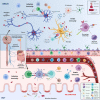Periphery and brain, innate and adaptive immunity in Parkinson's disease
- PMID: 33555429
- PMCID: PMC7952334
- DOI: 10.1007/s00401-021-02268-5
Periphery and brain, innate and adaptive immunity in Parkinson's disease
Abstract
Parkinson's disease (PD) is a neurodegenerative disorder where alpha-synuclein plays a central role in the death and dysfunction of neurons, both, in central, as well as in the peripheral nervous system. Besides the neuronal events observed in patients, PD also includes a significant immune component. It is suggested that the PD-associated immune response will have consequences on neuronal health, thus opening immunomodulation as a potential therapeutic strategy in PD. The immune changes during the disease occur in the brain, involving microglia, but also in the periphery with changes in cells of the innate immune system, particularly monocytes, as well as those of adaptive immunity, such as T-cells. This realization arises from multiple patient studies, but also from data in animal models of the disease, providing strong evidence for innate and adaptive immune system crosstalk in the central nervous system and periphery in PD. Here we review the data showing that alpha-synuclein plays a crucial role in the activation of the innate and adaptive immune system. We will also describe the studies suggesting that inflammation in PD includes early changes in innate and adaptive immune cells that develop dynamically through time during disease, contributing to neuronal degeneration and symptomatology in patients. This novel finding has contributed to the definition of PD as a multisystem disease that should be approached in a more integratory manner rather than a brain-focused classical approach.
Keywords: Alpha-synuclein; Microglia; Monocyte; Neuroinflammation; Parkinson; T-Cell.
Figures

References
Publication types
MeSH terms
Grants and funding
LinkOut - more resources
Full Text Sources
Other Literature Sources
Medical

